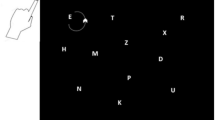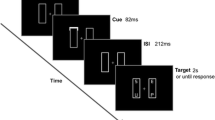Abstract
Over the past decade, evidence has accumulated that performance in attention, perception, and memory-related tasks are influenced by the distance between the hands and the stimuli (i.e., placing the observer’s hands near or far from the stimuli). To account for existing findings, it has recently been proposed that processing of stimuli near the hands is dominated by the magnocellular visual pathway. The present study tests an implication of this hypothesis, whether perceptual grouping is reduced in hands-proximal space. Consistent with previous work on the object-based capture of attention, a benefit for the visual object in the hands-distal condition was observed in the present study. Interestingly, the object-based benefit did not emerge in the hands-proximal condition, suggesting perceptual grouping is impaired near the hands. This change in perceptual grouping processes provides further support for the hypothesis that visual processing near the hands is subject to increased magnocellular processing.



Similar content being viewed by others
Notes
It is worth noting that the use of red stimuli in the current experiment will not inhibit M-pathway activity. Indeed several previous studies that reported increased M-pathway contribution used displays that could include a red stimulus (e.g., Goodhew et al. 2014; Gozli et al. 2014; Kelly and Brockmole 2014). It is only when the light source is diffuse (i.e., the entire background of the monitor) that the M-pathway is inhibited by red light. In the single-cell recording studies that initially demonstrated the effect, when light sources were focused enough such that they did not cover the surround portion of the receptive fields, no inhibition was found (Wiesel and Hubel 1966).
References
Abrams RA, Weidler BJ (2014) Trade-offs in visual processing for stimuli near the hands. Atten Percept Psychophys 76:383–390
Abrams RA, Davoli CC, Du F, Knapp WH, Paull D (2008) Altered vision near the hands. Cognition 107:1035–1047
Barense MD, Gaffan D, Graham KS (2007) The human medial temporal lobe processes online representations of complex objects. Neuropsychologia 45:2963–2974
Brainard DH (1997) The psychophysics toolbox. Spat Vision 10:433–436
Bush WS, Vecera SP (2014) Differential effect of one versus two hands on visual processing. Cognition 133:232–237
Chan D, Peterson MA, Barense MD, Pratt J (2013) How action influences object perception. Front Psychol 4:462
Cosman JD, Vecera SP (2010) Attention affects visual perceptual processing near the hand. Psychol Sci 21:1254–1258
Davoli CC, Brockmole JR (2012) The hands shield attention from visual interference. Atten Percept Psychophys 74:1386–1390
Davoli CC, Du F, Montana J, Garverick S, Abrams RA (2010) When meaning matters, look but don’t touch: the effects of posture on reading. Mem Cogn 38:555–562
Davoli CC, Brockmole JR, Du F, Abrams RA (2012a) Switching between global and local scopes of attention is resisted near the hands. Vis Cogn 20:659–668
Davoli CC, Brockmole JR, Goujon A (2012b) A bias to detail: how hand position modulates visual learning and visual memory. Mem Cogn 40:352–359
Doniger GM, Foxe JJ, Murray MM, Higgins BA, Snodgrass JG, Schroeder CE, Javitt DC (2000) Activation timecourse of ventral visual stream object-recognition areas: high density electrical mapping of perceptual closure processes. J Cogn Neurosci 12:615–621
Gallivan JP, Cant JS, Goodale MA, Flanagan JR (2014) Representation of object weight in human ventral visual cortex. Curr Biol 24:1–8
Ganel T, Goodale MA (2003) Visual control of action but not perception requires analytical processing of object shape. Nature 426:664–667
Goodhew SC, Gozli DG, Ferber S, Pratt J (2013) Reduced temporal fusion in near-hand space. Psychol Sci 24:891–900
Goodhew SC, Boal HL, Edwards M (2014a) A magnocellular contribution to conscious perception via temporal object segmentation. J Exp Psychol Hum Percept Perform 40:948–959
Goodhew SC, Fogel N, Pratt J (2014b) The nature of altered vision near the hands: evidence for the magnocellular enhancement account from object correspondence through occlusion. Psychon Bull Rev 21:1452–1458
Gozli DG, West GL, Pratt J (2012) Hand position alters vision by biasing processing through different visual pathways. Cognition 124:244–250
Gozli DG, Ardron J, Pratt J (2014) Reduced visual feature binding in the near-hand space. Atten Percept Psychophys 76:1308–1317
Han S, Ding Y, Song Y (2002) Neural mechanisms of perceptual grouping in humans as revealed by high density event related potentials. Neurosci Lett 319:29–32
Hommel B, Müsseler J, Aschersleben G, Prinz W (2001) The theory of event coding (TEC): a framework for perception and action planning. Behav Brain Sci 24:849–878 (discussion 878–937)
Kelly SP, Brockmole JR (2014) Hand proximity differentially affects visual working memory for color and orientation in a binding task. Front Psychol 5:1–5
Kimchi R, Yeshurun Y, Cohen-Savranski A (2007) Automatic, stimulus-driven attentional capture by objecthood. Psychon Bull Rev 14:166–172
Livingstone M, Hubel D (1988) Segregation of form, color, movement, and depth: anatomy, physiology, and perception. Science 240:740–749
McAuliffe J, Pratt J (2005) The role of temporal and spatial factors in the covert orienting of visual attention tasks. Psychol Res 69:285–291
Pelli DG (1997) The VideoToolbox software for visual psychophysics: transforming numbers into movies. Spat Vision 10:437–442
Posner MI, Cohen Y (1984) Components of visual orienting. Atten Perform X Control Lang process 32:531–556
Reed CL, Grubb JD, Steele C (2006) Hands up: attentional prioritization of space near the hand. J Exp Psychol Hum Percept Perform 32:166–177
Taylor JET, Witt JK, Sugovic M (2011) When walls are no longer barriers: perception of wall height in parkour. Perception 40:757–760. doi:10.1068/p6855
Taylor JET, Gozli DG, Chan D, Huffman G, Pratt J (2015) A touchy subject: advancing the modulated visual pathways account of altered vision near the hand. Transl Neurosci 6:1–7
Theeuwes J, Atchley P, Kramer AF (2000) On the time course of top-down and bottom-up control of visual attention. In: Monsell S, Driver J (eds) Control of cognitive processes: attention and performance XVIII. MIT Press, Cambridge, pp 105–124
Tseng P, Bridgeman B (2011) Improved change detection with nearby hands. Exp Brain Res 209:257–269
Vatterott DB, Vecera SP (2013) Prolonged disengagement from distractors near the hands. Front Psychol 4:533
Witt JK, Linkenauger SA, Proffitt DR (2012) Get me out of this slump! visual illusions improve sports performance. Psychol Sci 23:397–399
Wiesel TN, Hubel DH (1966) Spatial and chromatic interactions in the lateral geniculate body of the rhesus monkey. J Neurophysiol 29:1115–1156
Yeshurun Y (2004) Isoluminant stimuli and red background attenuate the effects of transient spatial attention on temporal resolution. Vis Res 44:1375–1387
Author information
Authors and Affiliations
Corresponding author
Rights and permissions
About this article
Cite this article
Huffman, G., Gozli, D.G., Welsh, T.N. et al. Hand position influences perceptual grouping. Exp Brain Res 233, 2627–2634 (2015). https://doi.org/10.1007/s00221-015-4332-7
Received:
Accepted:
Published:
Issue Date:
DOI: https://doi.org/10.1007/s00221-015-4332-7




